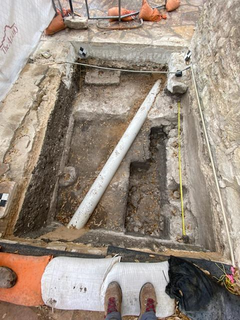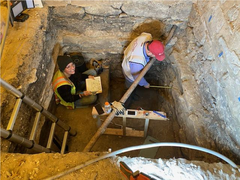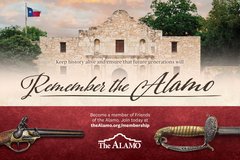During the week of March 2, 2020, archaeological work occurred north of the Long Barrack in association with the installation of safety bollards, as well as south of the Long Barrack and around the Church in association with the preservation work. In all, three areas around the compound had active excavations. The remainder of the work consisted of documentation of completed excavation units.
Archaeology Update — Shovel Testing Shows Signs of Features on North Side of the Long Barrack
North of the Long Barrack, the University of Texas at San Antonio- Center for Archaeological Research (UTSA-CAR) conducted shovel testing in the area to be impacted by the installation of the safety bollards. The archaeologists set out to conduct 30 shovel tests, although there were fewer excavated due to the presence of a concrete duct-bank that prevented any digging. The concrete duct-bank is a previous impact to the area that likely removed any intact archaeology deposits in its path.
The shovel tests produced artifacts of mixed context, providing evidence of the disturbance over the years. A few of the shovel tests encountered limestone that may be of interest to further explore. One question that has yet to be answered with the archaeological investigations is whether the Long Barrack continued further north. The shovel tests with possible limestone or limestone blocks could hold some promise to answer that question. Artifacts recovered included Native American made pottery, glass of various colors, European ceramics, unidentifiable metal, and stone flakes.
The western profile of the project area revealed that there are intact mesquite or cedar block just below the concrete that are part of the wood block paving of the road. The wood blocks were installed as a way to pave the streets around Alamo Plaza to prevent the muddy roads that had been common by the late 1800s. Much of the mesquite or cedar block pavers were removed during the street improvements in 1976. Initially, the pavers had been capped with asphalt, but large sections were removed in 1976 when the current flagstone pavers were installed.

Archaeological work associated with the preservation of the Long Barrack and Church focused on two areas: the unit on the south side of Long Barrack, and a unit on the south side of the Church. All other units have completed excavations, and have been documented by the archaeologists.
On the south side of the Long Barrack, Unit 9b has encountered what appears to be bedrock, or hardpan. The foundation of the Long Barrack has been constructed on this stable, naturally occurring formation. The archaeologists are considering the next step to take in this unit, as there is more area that is immediately against the foundation that may need to be excavated to expose the foundation stones.
On the south side of the Church, excavations have been conducted to approximately 63 inches below datum. A few stones had been exposed that may be similar to the bedrock/hardpan that is noted in the other units around the site. It is likely that one more level may need to be excavated in this unit. Archaeologists are conferring with the structural engineer and the preservation team to determine what is the next steps. The week was completed with documentation of the unit for the archaeological records.


Archaeologists from the preservation project will return the following week to finish up the last bit of excavations and documentation


